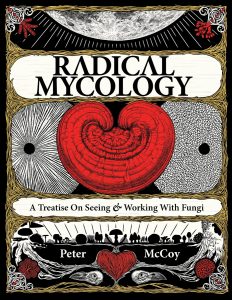During week two, I looked at some of the biological processes and functions of Mycorrhizae. I have been reading Radical Mycology, written by local mycologist Peter Mccoy. The text explores the uniqueness of fungal biology, and the roles of micro and macro fungi. It includes information for identifying mushrooms and mycorrhizal fungi, and talks about the ways that lichen are indicators of environmental health. It is recently written, and uses language that is helpful, and less wordy than some of the more confusing texts I have read. I also like that there are tools for making fungal medicine, growing fermented fungi, and cheaply cultivating mushrooms.
I focused on the information about Mycorrhizae, and these are some of the points that stood out to me.
Mycorrhizae..
-play a big function in nutrient cycling within the soil and plant roots.
-move carbon, nitrogen, sulfur, phosphorus, and other essential elements throughout the rhizosphere.
-are central to the carbon cycle
-use production of strong acids to release nutrients from rocks into soil webs.
-Are found on the surface, and inside of most rocks
-extract phosphorus and potassium from rocks with the use of Oxalic Acid
Mycorrhizae can also play a large role in the remediation of soils
Mycorrhizoremediation
Heavy metals are known to affect soil Ph, and health. Mycorrhizae are known to significantly reduce negative impacts of toxic heavy metals such as mercury, arsenic, and cesium on environment. Current restoration focuses on replacing soils (that are not fungally dominated), and unfortunately chemical fertilizers are often added in the process.
Major functions of Mycorrhizae
A large feature of Mycorrhizae is the Hartig Net, a main nutrient exchange interface, that is essentially repeated branching of the inner mantle. It is involved in the bi-directional movement of nutrients. Fungal are capable of absorbing glucose and/or fructose from root cells, converting it into carbohydrates, trehalose, and mannitol, or into insoluble carbohydrate, glycogen. Complex hyphal branching is involved in the absorption of sugars from root cells into the hartig net hyphae and back into the mantle of the Mycorrhizae.

